This site is part of various affiliate programs. Links may give us a small compensation for any purchases you make, at no additional cost to you. Please read the disclaimer policy for full details.
If you’re in a hurry and don’t have time to read the article, then the best ultra short throw projector 4K is the Samsung LSP7T, which is a premium product for a fair price.
Ultra short throw (UST) projectors are relatively new technology, particularly when displaying 4K images, so it can be difficult to find reliable information on what makes the best short throw projector 4K.
Following extensive research, I have covered only the top UST 4K projectors in this article, including the best UST laser projector, and show you exactly why each one deserves its place in your home theater.
There is also a full guide as to what makes the best 4K ultra short throw projector, so you can follow this up with your own research, after reading the best ultra short throw projector reviews.
The Overall Best Ultra Short Throw Projector 4K [2024]
4K Ultra Short Throw Projector
- The Best 4K HDR projector, as it supports HDR10+, with 4K from 0.47″ DMD chip and a max image size of 120 inches
- Very well-designed menus and apps for easy 4K Netflix, Disney+, etc streaming
- Seems much brighter than the 2200 lumens would suggest, and usable in daylight
- Around 10 seconds startup time with very low fan noise
- Rock solid HDMI connectivity and super easy setup
The Best Cheap Ultra Short Throw 4K Projector
The Best Cheap Ultra Short Throw Projector
- Projects a 1080p picture with a 100-inch diagonal at 10-inches from the wall
- Fantastic picture quality with 3600 Lumens brightness, and with lovely, saturated colors
- 3 LCD lasers, which are offer far superior optical quality than LED lamps
- No rainbow effect or other optical distortions
- Built-in Android TV, letting you stream Netflix, Disney+, Prime & more
- 2.1 Yamaha speaker system within the projector
An Alternative to Ultra Short Throw Projectors
Although ultra short projectors are the pinnacle of home projection technology, there’s no doubt that they are very expensive.
If you want a fantastic projector, but don’t want to empty your bank account, then I highly recommend the Xgimi Elfin, a portable, budget-friendly short throw projector.
Portable and Powerful
- Fantastic 1080p image quality for such a small projector
- Loud speakers outperform their 3W rating
- Bright enough to use in indirect daylight (at under 50-inches picture size)
- Auto-keystoning and focus plus object avoidance work perfectly
- Streams Netflix, Prime and Disney+ direct through the in-built Android TV with no issues
- Lack of bass in the speakers
- No battery
Compare the Top UST 4K Projectors
See the key differences between the best short throw 4K projectors, and then read the UST projector reviews further down this article.
Projector | Throw Distance & Image Size | Resolution & Brightness | Native Netflix 4K Streaming? | Check Price | |
[The Best UST 4K Projector] | 120" image at 16.4 inches | 4K 0.47" DMD Chip & 2200 ANSI Lumens | Yes | ||
120" image at 7.2 inches | 4K 0.66" DMD Chip & 2700 ANSI Lumens with 3 channel laser | Yes | |||
130" image at 9.4 inches | 4K 0.66" DMD Chip & 2800 ANSI Lumens | Yes | |||
120" image at 13.8 inches, with included ALR screen | 4K 0.47" DMD Chip & 2700 ANSI Lumens | Yes | |||
120" image at 14.5 inches | 4K 0.47" DMD Chip & 3000 ANSI Lumens | No - with separate streaming stick | |||
120" image at 11.3 inches | 4K 0.47" DMD Chip & 2500 ANSI Lumens | No - with separate streaming stick | |||
120" image at 11.3 inches | 4K 0.47" DMD Chip & 2500 ANSI Lumens | No - with separate streaming stick | |||
120" image at 11.7 inches | 4K 0.47" DMD Chip & 2400 ANSI Lumens | Yes for Disney+ & Prime - Netflix currently with separate streaming stick due to newness of this model | |||
[Highly Commended] | 130" image at 20.4 inches | 4K 0.47" DMD Chip & 2200 ANSI Lumens | No - with separate streaming stick | ||
120" image at 12.5 inches | 4K 0.47" DMD Chip & 2500 ANSI Lumens | Yes | |||
[Best Ultra Short Throw Projctor for Gaming] | 130" image at 20.4 inches | 3LCD 4K & 4000 ANSI Lumens | Yes |
What Makes the Best Ultra Short Throw 4K Projector?
So you can see how I have compared the best ultra short throw 4K projectors, my list of criteria are below, along with full explanations of each. I believe these to be the most important characteristics to consider when looking for a short throw 4K laser projector. Feel free to use this list for your own research, if you want to look at any further models.
- Picture Quality Issues. Consider chromatic dispersion & aberration, the rainbow effect, and overall colors, clarity and sharpness.
- Brightness. Measured in lumens and is a good indicated of how well the projector will perform in a bright room.
- Number of Lasers. Does the projector have 3 color lasers, or 1 laser and a color wheel?
- Throw Ratios: Ultra Throw vs Short Throw. A short throw projector has a throw ratio of 0.4 to 1, while a UST projector is below 0.4.
- Smart Features & Apps. How good is the native OS and any apps? Will you need to use a separate streaming stick, meaning extra hassle and more remote controls?
- Ease of Setup. Does the projector come with proper instructions or a guided setup?
- Resolution. We are concentrating on 4K in this article, as these projectors create a much better image at 100 inches plus, but be aware of pixel shifting – upscaling 1080p to 4K.
- Connectivity. Although most projectors have a variety of ports, check they have the relevant inputs for your entire home theater system.
- Value for Money. As UST 4K projectors are very expensive, you want to make sure that you are getting good value for money.
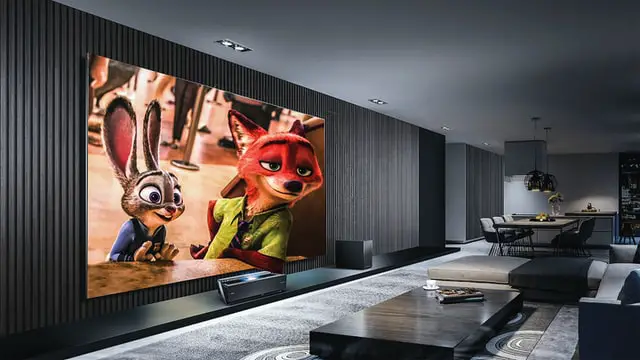
Picture Quality Issues
It goes almost without saying that the most important aspect of the best short throw laser projector is the picture quality, although the actual parts of picture quality that you should focus on are perhaps not so obvious.
You can take it as a fact that all ultra short throw 4K projectors have excellent color, clarity and sharpness – the difference between models in these characteristics is actually pretty minimal.
But where the best UST projectors do differ is in the details: the prevalence of rainbow effect, chromatic dispersion and chromatic aberration, as well as how they cope with regular rooms in normal daylight.
Two key terms are:
- Chromatic dispersion refers to light dispersing outside of the intended area, so that on-screen text appears fuzzy, and points of light, like stars, bleed into their surroundings. This is usually more noticeable at closer viewing distances, but can be a sign of poor focusing control on the projector. This is less common on high-end projectors.
- Chromatic aberration is where the light is split into different color bands on the edges of shapes, producing a multicolored halo around objects. This is a sign of lower quality glass in the lens.
Also, if you intend to game using your projector, you will want to take account of lag. This varies from around 40ms to 65ms for most projectors, which means that FPS games and the like can be difficult to play on some projectors.
Number of Lasers
Short throw 4K laser projectors mostly only come with 1 laser and a color wheel, although it is possible to buy 3 laser models (but this is not very common, even among the best 4K UST laser projectors).
The difference is that 1 laser models use a single color laser (usually blue) which is then shone through a rotating wheel that has filters for red, green and blue, to create the final image on screen, meaning that essentially the picture is built up in three successive images that are very slightly offset in time from one another.
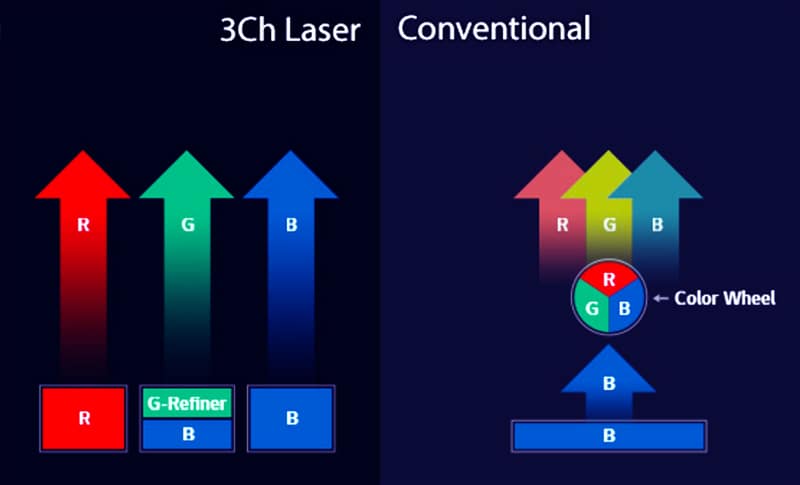
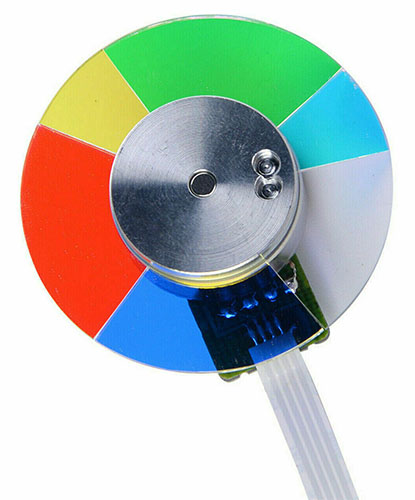
The issue with this approach is that the color wheel must move very fast in order to present an accurate picture, and this can introduce both noise and the rainbow effect. This tends to only be prevalent in dark films with sections of bright contrast, as you move your eyes about the screen, and is characterized by a colored rainbow around objects on screen.
Only around 10-15% of the population are susceptible to the rainbow effect though, so chances are you won’t notice this even if it is present, and it can become less noticeable with time.
3 channel lasers are found in the more premium 4K ultra short throw projectors, and comprise of three separate laser signals (usually red, blue and blue with a green phosphor filter) to create the projected image simultaneously. This eliminates the rainbow effect, and theoretically offers greater color clarity, but you would be hard pressed to see the difference between this and the one channel laser plus color wheel in practice.
Brightness
The brightness of a short throw home theater projector is a simple number shown in ANSI lumens – the larger the number the brighter the picture – but this isn’t the whole story.
Firstly, all 4K ultra short throw projectors are bright enough to deliver an excellent image in a darkened room, so the brightness of a projector is really only relevant to situations of non-ideal lighting, like using the projector in normal daylight.
All UST projectors will exhibit worse performance in this situation, but theoretically, those with a higher lumens value should perform better.
In practice though, this is not necessarily the case, as the lumens is calculated in a lab setting, not in real-world use. This means that you can’t rely on the lumens to identify projectors that work well in bright rooms, but I have indicated which projectors perform better in non-ideal lighting in the full reviews below.
Throw Ratios
Before we get into the projector reviews, it’s important to differentiate between ultra short throw projectors and short throw projectors.
They are separated based on throw ratio, which is shown in the format of, for example, either 0.3:1 or just 0.3. In this case, the 0.3 means that for every 1 inch of screen width, the projector must be 0.3 inches from the screen. Therefore, you need to multiply the decimal number by the width of the projected image you are aiming for to understand how far back the projector must be from the screen or wall.
If the ratio is 0.3 and you want a 100 inch image, you therefore need to place the projector 30 inches from the screen.
Short throw 4K projectors have a throw ratio of between 0.4 and 1.0, while ultra short throw projectors have a throw ratio below 0.4. The smaller the throw ratio, the closer to the screen you can place the projector.
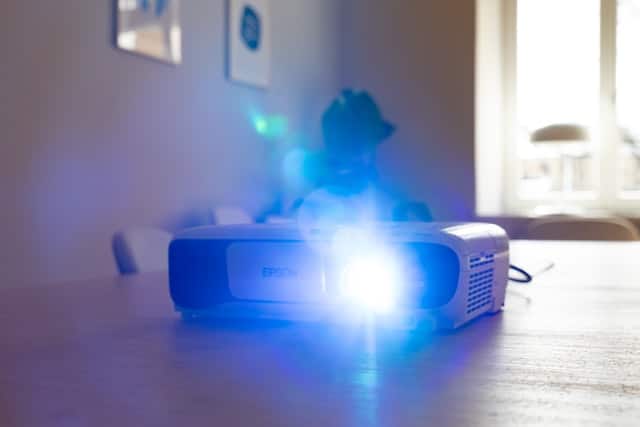
To get an idea of how powerful UST projectors are, and if one is suitable for you, then take a look at this video of the pros and cons of ultra short throw projectors.
Smart Features, Apps & Ease of Setup
There is a wide variety in the various smart features, apps and the OS of each UST projector.
Top models from the major manufacturers like LG and Samsung offer the best performance in this area, with custom-designed menus and remotes, and an OS that lets you use Netflix, Disney+ and the like directly through the projector.
Cheaper, non-major brand models like Vava, are not capable of running Netflix and other streaming apps directly through the projector, as they often use a basic version of Android that does not support these. Therefore, you need a separate streaming stick, like a FireStick or Roku if you want to stream any video.
This means extra expense, extra hassle in setup and a second remote, and really makes you feel that you are no longer using a premium product.
Related to this is ease of setup. Again the top manufacturers include easy to use software setup steps which takes only a few minutes to complete, while the more budget brands take more time and effort on your part to setup. This is really only an issue if you expect to be moving your projector, as setup must be re-completed for any movement, however small, to prevent seeing a distorted image.
Resolution
All of the projectors in this article are 4K resolution, which in my opinion deliver a far superior image at 100 inches plus screen size. They also use lasers, versus the bulbs of most 1080p projectors, resulting in much cleaner, more vivid images with more saturated colors, and give a much better ability to use the projectors in regular lighting.
The negative to using laser projectors (and projectors in general) is that you will see a slight loss of shadow detail when compared to OLED screens, but you would be hard pressed to see this in practice, unless in very dark scenes.
Some 4K projectors, such as models by Vava, do not display a true 4K picture though, and instead upscale a 1080p source to 4K within the projector. This is known as pixel shifting, and gives a noticeably worse image than projectors that display a true 4K source.
Read More:
See the best ultra short throw projectors, comparing 1080p with 4K
Connectivity
It’s standard to have WiFi with 4K projectors, but you should carefully check the ports available to ensure that you can connect your full home theater system. Although all projectors in this article come with in-built speakers, most people will want to use a separate sound system, and this can sometimes run into issues, particularly on the more budget models of projector.
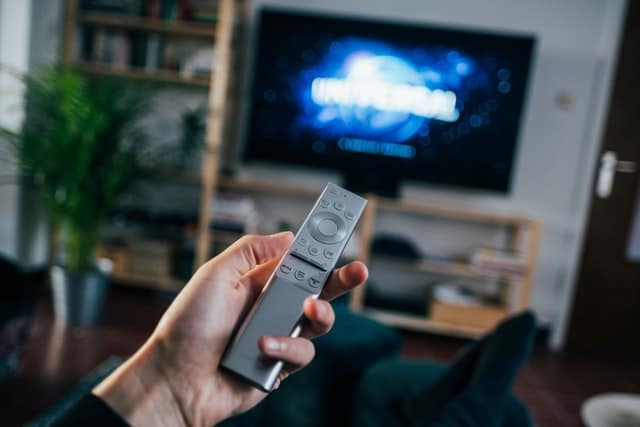
Does a UST Projector Need a Screen?
One of the advantages of a home theater projector is that you can project directly onto a wall (light gray is the ideal wall color).
But, because the projector points up at an extreme angle, it really picks out any flaws in your plaster and paintwork, highlighting wavy walls that a normal, front facing projector wouldn’t pick up.
This means that a screen is required for best performance.
My advice would be to test the projector with your wall, and if there are issues, you can buy a screen separately. Ideally, you want an ALR / CLR screen, which ‘ignore’ ambient light, so these are also well suited to brightly lit rooms. The best choices are probably those by Elite Screens, although there are plenty of other well-regarded screen manufacturers.
Related to this point, most projectors must also be placed a set distance below the screen, although this varies from manufacturer to manufacturer. You should check this distance to ensure that this placement is feasible for you and your screen positioning, and if it would block your center sound bar.
Read More:
The Top Ultra Short Throw Projector Reviews
Read the full reviews of the best ultra short throw laser projectors below. This ultra short throw projector comparison is based on the criteria above, with only the highest scoring and top UST projectors included.
1. Samsung LSP7T 4K UST Projector
The Best Ultra Short Throw Projector 4K
Specifications:
- Max. Image Size: 120″
- No. of Lasers: 1
- Brightness: 2200 Lumens
- Resolution: 4K 0.47″ DMD Chip
- Throw Ratio: 0.254
- Netflix Streaming? Yes
- Ease of Setup / Use: Easy
The Samsung LSP7T is the smaller brother of the 3 channel laser LSP9T, but other than the single laser and the slightly reduced max image size of 120 inches, there are no real quality downgrades in the LSP7T.
Picture Quality
The projector gives a 4K image with a throw ratio of 0.254, meaning that the back of the projector must be at 16.4 inches from the screen to deliver a 120 inch image. There are UST projectors that do better than this, but none that deliver at this quality.
Perhaps the real advantage of the Samsung though is the OS with single remote that has multiple voice assistants, including Google Assistant, Alexa and Bixby.
The user experience and apps are so solid that you can easily access all major apps, including Netflix and Disney+, for 4K streaming directly through the projector. This is a major bonus over the cheaper projectors which require a separate streaming stick.
Despite the seemingly low 2200 lumens brightness, the image is actually consistently bright across the frame, which cannot be said for projectors like the Optoma P2. The LSP7T actually looks brighter than this, despite the P2 nominally having 3000 lumens of brightness.
Directly comparing the Samsung LSP7T vs Vava 4K, the picture quality of the Samsung, along with the integrated sound, is far superior. The only real advantage that the Vava has is in its lower price.
Setup
Startup time is around 10 seconds, with just power and internet needed, if you are using the 2.2 sound system included (with two sub-woofers). Setup is very easy, guided by on-screen prompts, and really shows the effort that Samsung have put in to make a quality device.
Overall
Overall, you get better picture quality than OLED or QLED (although there are some crushed blacks of course), along with a very well designed curved remote that lets you access a near flawless OS that streams Netflix without trouble. Once you put this UST 4K projector into Samsung’s proprietary Filmmaker Mode, you’ll see why this is my best ultra short throw 4K projector.
- Pros:
- Supports HDR10+ for super vivid colors and very high contrast
- Brightness is very consistent across the image and seems much brighter than 2200 lumens
- OS and menus / apps are very easy to use, and includes native Netflix, Disney+, etc for streaming
- Around 10 seconds startup time with no noticeable fan noise
- Rock solid HDMI connectivity to sound systems and other sources
- Cons:
- A few people have been delivered models that are dead on arrival
- Only one laser with color wheel
2. Hisense PX1-PRO 4K Ultra Short Throw Projector
Triple Laser Ultra Short Throw Projector
Specifications:
- Max. Image Size: 130″
- No. of Lasers: 3
- Brightness: 2200 Lumens
- Resolution: 4K 0.47″ DMD Chip
- Throw Ratio: 0.25
- Netflix Streaming? No – with separate streaming stick
- Ease of Setup / Use: Easy
If you are wanting one of the latest models of ultra short throw projectors, and one that offers three lasers at a fair price, then the Hisense PX1-Pro is a fantastic option.
Picture Quality
With Hisense essentially founding the field of laser projectors back in 2007, you would expect picture quality to be good, and it is in fact excellent.
Unlike many of the cheaper short throw projectors, the PX1-Pro has three separate laser beams – red, green and blue – meaning that there is no need for a color wheel, and therefore no possibility of the rainbow effect.
This benefits the otherwise low 2200 ANSI Lumens of brightness, as the three separate laser beams are able to produce a brighter image than a similarly measured single laser projector that is usable in daylight, although as with any projector, is best in a darkened room.
The in-built 30W speakers with Dolby Atmos round out the high-end experience, and can be complemented with a separate sound system routed through HDMI if you wish, although there is no need for this in a smaller space.
The 0.25 throw ratio means the projector operates between 0.9 and 1.7 feet from the wall to produce an image between 90 and 130 inches, big enough for any home theater.
Lag of 30ms when in gaming mode is definitely good enough for gaming, although doesn’t beat the superior 16ms lag of the Epson EpiqVison LS500.
Setup
With a plug-and-plug setup, it couldn’t be easier to get started with the Hisense, with Android TV pre-installed allowing for access to most streaming services.
Currently, Netflix is not supported and it is unknown whether this is coming. Still, a Roku in the projector’s USB port is enough to get you access to Netflix, although you do then have to handle two separate remote controls, which is always a small annoyance.
You can connect a separate audio system through HDMI, but the real advantage of this projector is that you don’t really need to. It works straight out of the box with minimal fuss.
Overall
The Hisense PX1-Pro is a beatiful machine that looks good and projects an amazingly colorful image. Sound quality is strong and the setup process is simple and straightforward.
If you are looking for an ultra short throw laser projector that is as easy to use as your phone, but produces one of the top images in the market, the PX1-Pro is the choice for you.
- Pros:
- Three lasers and 4K for fantastic image detail
- Surprisingly bright, vivid colors for 2200 Lumens
- Looks good in your room and has decent 30W Dolby Atmos sound
- 30ms lag reduces stutter when watching sports or action movies
- Cons:
- No native Netflix app
- Fairly expensive
If you want to save some money and are using the projector in a properly light-controlled environment, then take a look at the non-Pro version, the Hisense PX1 which comes in at 2000 ANSI Lumens, and loses Dolby Vision, but is otherwise the same as its bigger brother.
3. LG HU715QW 4K Ultra Short Throw Projector
Mew Model Ultra Short Throw 4K Projector
Specifications:
- Max. Image Size: 120″
- No. of Lasers: 1
- Brightness: 2500 Lumens
- Resolution: 4K 0.47″ DMD Chip
- Throw Ratio: 0.22
- Netflix Streaming? Yes
- Ease of Setup / Use: Easy
One of the top new 4K UST projectors, the LG HU715QW appears to have it all – 4K and good brightness, all at a reasonable price point for this type of projector.
Picture Quality
Although only a single laser setup with color wheel, the 120 inch image is superb, with colors given a bright, vivid quality that is almost indistinguisable from the more expensive competitors, like the LG HU85LA.
This model has 4K with a short throw ratio of 0.22, meaning that it can produce a 120 inch image at 12.5 inches from your screen or wall.
With a brightness of 2500 ANSI Lumens, you will be just about ok to use this in a brighter room, although you will benefit from an ALR screen to control ambient light.
With a 54ms input lag, you won’t want to use this for gaming, but for all other uses, it is excellent.
Setup
You can go from unboxing to a fully working projector in minutes with the simple guided setup, allowing you to keystone the image to your wall or screen.
There are plenty of included apps, including Netflix, Disney+ and Prime, although you might find it easier to stream on a Firestick or similar due to a less intuitive to use remote.
The in-built speakers are very good, and can be complimented with an external sound system connected via an optical port, HDMI, or wirelessly over Bluetooth, which really adds to the value of this device.
Overall
The LG CineBeam HU715QW is a real quality device, taking the best features of the older HU85LA and updating them into this brand new package.
With minimal time to set up, and phenomenal picture quality right out of the box, the HU715QW is a very good choice of 4K ultra short throw projector for those wanting the latest model.
- Pros:
- Quick and easy setup
- Fantastic image quality right out of the box
- Bluetooth speaker support
- HDR10 and HLG support
- Cons:
- Streaming works best with a Firestick or Roku
- 54ms input lag is less suitable for gaming
4. WeMax Nova 4K Ultra Short Throw Projector
The Best Budget 4K Ultra Short Throw Projector
Specifications:
- Max. Image Size: 150″
- No. of Lasers: 1
- Brightness: 2100 Lumens
- Resolution: 4K 0.47″ DMD Chip
- Throw Ratio: 0.233
- Netflix Streaming? Only in 1080p
- Ease of Setup / Use: Medium
The WeMax Nova offers a strong performance considering its price, and is also one of the cheapest UST 4K projectors available now.
Picture Quality
You get 4K with pixel shifting from 1080p using the 0.47-inch DMD chip, which delivers vivid, bright colors and excellent image quality that beats other cheap models, like those by Vava, in a side-by-side test.
With a throw ratio of 0.233, the projector only needs to be 13 inches from the wall to deliver a 120 inch image. This short throw distance helps partially negate the low brightness of 2100 lumens, although you still wouldn’t want to use this projector in too bright of a room.
With 40ms of lag, the projector can definitely be used for gaming. Lag is significantly larger than a dedicated TV, but is actually among the shortest for a projector of this caliber.
Comparing the WeMax Nova vs Vava 4K, the WeMax offers a much more solid picture, with decent contrast and colors, mainly thanks to the 4K display.
And looking at the WeMax Nova vs Optoma P2, the P2 does offer a comparable picture quality, and a brighter image, but suffers from a less powerful interface, and doesn’t quite match the value for money of the WeMax.
Setup
Setup itself is relatively easy, if more involved than with a Samsung, but the real weakness of this projector is in the OS, based around a less customized version of Android.
This doesn’t support 4K streaming of Netflix, and misses out some larger streaming apps, so a FireStick or Roku will be required, which means an extra remote and slightly more hassle to use the projector.
Overall
Nonetheless, the low price makes up for the Nova’s weak points, and combined with a long 25,000 hours laser life and low fan noise make this the top pick for those looking for a value for money, affordable 4K ultra short throw projector.
- Pros:
- Strong 4K performance
- Excellent image quality, with bright, vivid colors
- Relatively small & excellent value for money
- Only 40ms lag, which is better suited to gaming than other projectors
- Cons:
- Poor OS that cannot handle Netflix streaming in 4K – use a separate streaming stick
- Quality control on the lenses seems less good, but customer service replaces units quickly
5. XGIMI Aura 4K Ultra Short Throw Projector
Brand New Model of 4K Ultra Short Throw Projector
Specifications:
- Max. Image Size: 150″
- No. of Lasers: 1
- Brightness: 2400 Lumens
- Resolution: 4K 0.47″ DMD Chip
- Throw Ratio: 0.233
- Netflix Streaming? Currently with streaming stick – see review
- Ease of Setup / Use: Medium
The XGIMI Aura offers an outstanding performance for its price, and at the time of writing is the cheapest 4K ultra short throw laser projector.
Picture Quality
Picture quality is very good considering this a pixel shifted 4K device, delivering vivid, bright colors and excellent image quality that is not too far behind that offered by Samsung.
Blacks are of course not as deep as you would get on a dedicated TV, and you can get better with the Samsung projectors, but for a significantly higher cost.
With a throw ratio of 0.233, the projector only needs to be 11.7-inches from the wall to deliver a 120 inch image. This short throw distance combines well with the brightness of 2400 lumens, which is good for normal daytime viewing and works even with sunlight coming into the room.
Setup
Setup itself is not automatic, meaning that you must perform the 8-point keystone correction yourself, although you can use autofocus to get a sharp image.
The remote is a strong point, as with other XGIMI projectors, offering a well designed device that supports voice controls.
With a 12 second boot time, you can quickly get into watching your shows on Disney+ and Prime, although the Netflix app does not currently work, but will once Netflix have verified this model. This means that you need a separate streaming stick at the moment for Netflix viewing.
Overall
Despite a couple of issues, the lower price and long 25,000 hours laser life make this one of the top picks for those looking for a value for money, budget 4K ultra short throw projector, and it will only become more popular once Netflix have certified the model, which is sure to happen in the near future.
- Pros:
- Surprisingly good picture for a pixel shifted 4K device, with bright, vivid colors
- 12 second boot time and Android TV with excellent voice controlled remote
- Easy streaming of Disney+ and Prime
- Low lag, which is better suited to gaming than other projectors
- Cons:
- Not yet verified for Netflix streaming – use a separate streaming stick until then
- Can have a longer lead time for shipping as this is a brand new device
6. LG HU85LA 4K Ultra Short Throw Projector
3 Channel Laser Projector
Specifications:
- Max. Image Size: 120″
- No. of Lasers: 3
- Brightness: 2700 Lumens
- Resolution: 4K 0.66″ DMD Chip
- Throw Ratio: 0.19
- Netflix Streaming? Yes
- Ease of Setup / Use: Easy
If you are looking for the ultimate in image quality, with a three channel laser projector, then the LG HU85LA is the current top model on the market, only let down by its very high price tag.
Picture Quality
There is really no negative to the picture that this UST projector delivers. Colors are vivid, and the image is bright and clear, the 2700 lumens making is suitable even for viewing in daylight.
Delivering a 120 inch image at only 7.2 inches from the screen is a remarkable achievement, and shows the premium quality of the LG lens with its 0.19 throw ratio, and means that this is the best projector for small spaces – you can even get a remarkable 90 inch image at only 2 inches from the wall.
Lag is around 50ms, which makes this suitable for gaming, and the HDR10 compatibility helps boost contrast and colors still further, although bear in mind that blacks are still crushed compared to OLED TVs, as you would expect with any projector.
Using a 0.66-inch DMD chip means that the image has to be pixel-shifted back and forth at 120 Hz, which is half as much as those that use the 0.47-inch chip, which are pixel-shifted at 240 Hz.
Setup
Setup is very straightforward, following the on-screen guided process, and the menus and OS are well-designed to make it easy to stream Netflix and other services. Perhaps the menus are not quite as streamlined as those offered by Samsung, but they are still far better that those of the budget brands like Vava, or even Optoma.
Overall
For a projector with three lasers, the HU85LA is relatively cool running, and has a quiet fan. Being able to easily watch a movie in broad daylight or the lights on is a massive bonus, and the quality of the LG really shines through in that situation.
If you want the ultimate best 4K UST projector, and the price tag doesn’t put you off, then the LG HU85LA is it.
- Pros:
- The ultimate in picture quality, even in broad daylight thanks to th 0.66″ DMD chip
- HDR10 compatible for vivid, clear colors and contrast
- Very short throw distance of 7.2″ for a 120″ screen
- Well designed menus and apps that let you easily setup the unit and stream 4K Netflix
- Cons:
- Very expensive
- In practice, Samsung’s menu system is slightly better
7. Samsung LSP9T 4K Ultra Short Throw Projector
Outstanding picture for a huge price tag
Specifications:
- Max. Image Size: 130″
- No. of Lasers: 1
- Brightness: 2800 Lumens
- Resolution: 4K 0.66″ DMD Chip
- Throw Ratio: 0.189
- Netflix Streaming? Yes
- Ease of Setup / Use: Easy
The Samsung LSP9T suits those who want a truly massive 130 inch picture in a very easy to use package. If you can make do with a 120 inch image, then the LSP7T is essentially the same projector, but at a much lower price and with only a 0.47-inch DMD chip
Picture Quality
You can get a 130 inch image with the projector only 9.4 inches from the screen, or an incredible 100 inch image at 4.45 inches distance, thanks to the 0.189 throw ratio.
The color and clarity is almost unbelievable for a home device, with a variety of modes including dynamic mode and filmmaker mode for watching regular TV in daylight, or films as the director truly intended, respectively.
Brightness is very good, at 2800 lumens, making this much more well suited to brightly lit rooms than the LSP7T, although given the large price disparity between the two models, I don’t feel that this justifies the extra price of the LSP9T.
The only reason you might prefer the LSP9T is if you value a native resolution of 2716 x 1528 pixels versus the 1920 x 1080 of the LSP7T.
Both use pixelf-shifting to increase the resolution to 4K, but the LSP9T uses a larger 0.66-inch DMD chip, meaning that image quality should be improved over the LSP7T.
Setup
As with the other Samsung projector, setup is very easy and no hassle, with you using the remote to adjust the projected image. Following the 10 – 15 second startup time, a trapezoidal grid containing 15 dots is first projected, and you use the remote to select a dot to drag it up and down, or left and right, until the image is rectangular.
The remote itself is the same as on the LSP7T, and is designed in a unique curved shape that allows you to access Samsung’s excellent series of menus and apps or Apple TV, to stream Netflix, Disney+ and others in native 4K, using either the remote buttons or one of the many included voice assistants.
Overall
With such an easy installation, one of the shortest throw distances around and a 130 inch image, the Samsung LSP9T would be top of the list if it was a more competitive price.
Generally, I would recommend the LSP7T over this for most people, but this stands out if you need a very bright image, or would benefit from an really ultra short throw ratio and are not budget limited.
- Pros:
- Incredible color and clarity with a dynamic mode for using with regular lighting and HDR10+
- Very short throw ratio allowing a 130 inch image at 9.4 inches from the screen
- Very easy-to-use menus with Alexa, Bixby & Google Assistant supporting Netflix streaming directly
- In-built 4.2 channel sound system
- 10 – 15 second start up time and easy install
- Cons:
- Menus can be too bright as they don’t respect movie modes and the custom screen settings you choose for watching video
- As with other projectors, blacks are not as good as OLED TVs
8. Optoma CinemaX P2 4K Ultra Short Throw Projector
One of the better budget UST projectors
Specifications:
- Max. Image Size: 120″
- No. of Lasers: 1
- Brightness: 3000 Lumens
- Resolution: 4K 0.47″ DMD Chip
- Throw Ratio: 0.25
- Netflix Streaming? With streaming stick
- Ease of Setup / Use: Medium
The Optoma P2 is one of the better budget projectors, that outshines rivals like the Vava, but still lags behind the Samsungs and LGs.
Picture Quality
The Optoma gives 3000 lumens of brightness, but this is offset by the relatively long throw ratio of 0.25.
This means that to get a 120 inch image, the projector must be 14.5 inches from the wall, and this extra distance means more light dispersal, effectively making the projected image darker than you would expect, with more inconsistent brightness levels across the image that you see with more premium projectors, such as the Samsungs.
If you want to use this projector in daylight, you will require a CLR screen.
Nonetheless, colors are vivid and vibrant, and the picture is still very good, beating cheaper brands like Vava without question.
Gaming might be more of an issue with the 65ms lag, but again, this is much better than Vava can manage.
Comparing the Optoma P2 vs Samsung LSP7T, the P2 has a a much brighter output, as expected from a 3000 ANSI Lumens projector, but the Samsung still offers slightly better colors and contrast, along with a much easier to use interface.
Setup
A 40 – 50 second startup time is a little long when compared to the competition, and this is compounded by a poor setup experience that uses an app on your phone to align the image.
The version of Android used does not support direct 4K Netflix streaming, so you will require a separate streaming stick to use most streaming services, and there have been reports of quality issues with the HDMI handshake, which results in color splits appearing in the image.
Overall
Although the Optoma P2 is still a very good ultra short throw projector, it’s difficult to recommend it at its current price tag, which is above that of the far superior Samsung LSP7T. This is quite a large unit that just feels less premium than the Samsung, from the construction down to the on-screen menus.
Still, if you can find this for a good price, many people are very happy with it when used in combination with a decent CLR screen.
- Pros:
- HDR10 compatible and with 3000 lumens brightness for a vivid image
- When found for a low price is good value for money
- Can connect to Amazon Echo and Google Home for easy voice control
- Significantly better picture quality and setup than other budget brands like Vava
- Cons:
- Poor setup that utilizes a phone app
- Brightness doesn’t seem consistent, and is negated by throw ratio
- Fairly poor throw ratio – 120 inch image at 14.5 inches
9. Epson EpiqVision Ultra LS500 Laser Ultra Short Throw Projector – Best Ultra Short Throw Projector for Gaming
The brightest ultra short throw projector
Specifications:
- Max. Image Size: 130″
- No. of Lasers: 1
- Brightness: 4000 Lumens
- Resolution: 3LCD 4K
- Throw Ratio: 0.25
- Netflix Streaming? Yes
- Ease of Setup / Use: Medium
If you are looking for the best ultra short throw projector for gaming, then it is the Epson LS500, which offers a tiny 16.7ms input lag, far better than any other projector and comparable to some TVs.
Picture Quality
The Epson LS500 has a massive 4000 ANSI Lumens of brightness, making it suitable even for brighter rooms and potential use in daylight, if using an appropriate ALR screen.
Combined with the 16.7ms input lag and pixel-shifted 4K image, this is definitely a projector aimed at gamers who want access to really immersive gaming.
Picture quality is possibly the highest out of any current 4K ultra short throw projector, largely driven by the brightness giving excellent contrast, with deep, vivid colors.
Setup
Setup is a little more involved on the LS500, which lacks a motorized focus wheel, meaning that you must move it by hand. This makes getting an accurate focus harder, although it only adds a little extra time to the setup process, and does mean that you can very finely tune the focus.
There’s a lack of optical connection and Bluetooth for external speakers, meaning that you must use HDMI.
The operating system also feels a little outdated, and you may want to switch to using a Firestick or Roku, just for ease of use.
Overall
As one of the most expensive ultra short throw projectors on the market, you would expect very good picture quality from the Epson LS500, and it delivers in spades.
You get a super-bright image, with minimal input lag that is ideal for gamers, although this might be overkill for those just watching movies, where a cheaper model like the Samsung LSP7T might suffice.
But if you value brightness and speed, there is no better projector than the Epson LS500.
- Pros:
- Massive 4000 ANSI Lumens of brightness
- Only 16.7ms input lag, ideal for gamers
- Lovely picture quality and vivid colors
- Good-looking design that fits in well in any room
- Cons:
- No Bluetooth or optical audio for separate speakers
- User interface is a little harder to get to grips with
10. Hisense 120L5F 4K Ultra Short Throw Projector
UST projector plus 120″ screen
Specifications:
- Max. Image Size: 120″
- No. of Lasers: 1
- Brightness: 2700 Lumens
- Resolution: 4K 0.47″ DMD Chip
- Throw Ratio: 0.24
- Netflix Streaming? Yes
- Ease of Setup / Use: Hard
If you are looking for an all-in-one package of projector and screen, then the Hisense 120L5F is the perfect choice.
Picture Quality
Despite not being native 4K, with pixel shifting employed to bring out that resolution, the Hisense actually offers excellent picture quality, with HDR10 support keeping colors vibrant and contrast sharp.
Brightness is sufficient for use in daylight when using the included ALR screen, and you can project a 120 inch image onto it from 13.8 inches away.
Surprisingly, the 30W integrated sound bar gives very high quality sound. It’s not on the same level as a dedicated system, but it does mean that you can have a fully working setup with just this one package, without needing any accessories.
Setup
The screen setup is most problematic part of setup. There are plenty of how-to videos online which are a better source of help than the instructions.
Once you finally get the screen in place, then calibration can take several more hours using a link to the Hisense website, which I am not convinced will work forever. This means that once you have got the projector in place, you are very unlikely to want to move it again. This is not a portable 4K ultra short throw projector.
Overall
There might be better 4K short throw projectors on the market, but as an all-in-one package of projector, screen, and very good integrated sound, the Hisense is ideal for those looking for an easy (and relatively cheap) way into the world of 4K UST home theater projectors.
- Pros:
- All in one package with 120″ ALR screen is very good value for moneu
- 120″ 4K projection at 13.8 inches
- Integrated 30W sound bar delivers surprisingly high quality sound
- The ALR screen helps create fantastic image quality once calibrated
- Cons:
- Very complicated setup screen – not a projector to move once setup
- Pixel shifting to create 4K – but still excellent picture quality
11. OMMC 4K Ultra Short Throw Projector
One of the largest image sizes
Specifications:
- Max. Image Size: 150″
- No. of Lasers: 1
- Brightness: 2500 Lumens
- Resolution: Pixel shifting 4K
- Throw Ratio: 0.21
- Netflix Streaming? With streaming stick
- Ease of Setup / Use: Hard
The OMMC 4K is one of the essentially un-branded models being re-sold from Chinese manufacturers, and so quality is lower as you would expect.
OMMC themselves don’t appear to have a website, and their customer service email address is @outlook.com. Although it has passed the Amazon fake review checker, reading some of the reviews makes me suspicious, and this also appears to be from the same factory / manufacturer / design as the Vava 4K, only with a different badge.
Generally, that would make me steer clear of a manufacturer.
Picture Quality
Providing a 120 inch image at 11.3 inches, or 7.6 inches to get a 100 inch screen, the throw ratio of 0.21 is pretty good for a budget projector, although falls short of the high end models.
Colors are very good, and the HDR10 seems to help with the contrast. The 4K created through pixel shifting is completely fine, and in truth barely noticeable as not being native 4K.
Setup
Calibration can be difficult due to the poor remote design, and the need to often physically move the projector unit, rather than relying entirely on the on-screen calibration tool.
The projector runs a basic version of Android, and doesn’t have access to the most common streaming apps like Netflix, meaning that a separate streaming stick is required.
Overall
With a quick start up, and one of the lowest prices of any 4K UST projector, the OMMC 4K is a solid projector, although it doesn’t match the more premium feel or experience of the Samsung LSP7T, despite being a fairly similar price.
- Pros:
- Supports HDR10 for excellent picture quality
- Quick start up time
- Max image size of 150 inches
- Cons:
- Requires a separate streaming stick for Netflix and most streaming services
- Poor remote design, with apparently non-working buttons
- Difficult calibration thanks to the remote
- Possibility of fake reviews on Amazon
12. Vava 4K Ultra Short Throw Projector
Can be found relatively cheap
Specifications:
- Max. Image Size: 150″
- No. of Lasers: 1
- Brightness: 2500 Lumens
- Resolution: Pixel Shifting 4K
- Throw Ratio: 0.21
- Netflix Streaming? With streaming stick
- Ease of Setup / Use: Hard
The Vava 4K regularly appears and disappears from the listings on Amazon. It appears to be a white label projector from maybe the same Chinese manufacturer as OMMC and other brands, and so quality is lower than premium, but then so is the price.
Picture Quality
The picture itself is very solid, with good contrast and vivid colors – there’s nothing really wrong with it at all, and it is largely similar to more premium brands.
Sound quality is good, and overall there are no surprises for the price.
Setup
Setup is generally cumbersome, although the remote is better designed than for the OMMC.
You get a basic version of Android and need a separate streaming stick to access Netflix, Disney+ and the like.
Overall
There’s nothing inherently wrong with the Vava, but bear in mind you are not likely to get first class customer support if something does go wrong, and the general user experience is not on a par with Samsung or LG projector.
If you are on a very strict budget, then many are happy with the Vava, but I would recommend you spend a little more on a premium branded 4K projector.
- Pros:
- Max 150 inch screen size
- Good sound quality from integrated speakers
- Good picture quality with HDR10 support
- Cons:
- Cumbersome setup and calibration
- Lower quality overall
Final Thoughts on the Best UST Projector 2024
Ultra short throw projectors are such a relatively new technology, and come at such high price points, that it can be very difficult to understand which is the best UST projector for you.
They all have their own pros and cons, whether you want to only stream movies, play games, use your wall to project rather than a screen, or move the projector from room to room.
Ultimately, I feel that the Samsung LSP7T can’t be beaten for value for money as the best laser ultra short throw projector, offering a colorful, high contrast display that could grace any home theater, although any of those in this article might work well for you, depending on your individual requirements.
4K Ultra Short Throw Projector
- The Best 4K HDR projector, as it supports HDR10+, with native 4K and a max image size of 120 inches
- Very well-designed menus and apps for easy 4K Netflix, Disney+, etc streaming
- Seems much brighter than the 2200 lumens would suggest, and usable in daylight
- Around 10 seconds startup time with very low fan noise
- Rock solid HDMI connectivity and super easy setup
Further Info and Comparisons
Samsung LSP7T vs Optoma P2
The Optoma P2 gives a brighter image than the Samsung LSP7T, thanks to its 3000 ANSI lumens, making it more suitable for rooms where you cannot control the ambient light. The LSP7T does have a better picture quality overall though, along with a far superior on-screen interface, which makes using the Samsung much easier.
The Best Ultra Short Throw Projector for Gaming – Epson EpiqVision LS500
The best ultra short throw projector for gaming is the Epson EpiqVison LS500, as it has an ultra-low input lag of 16.7ms, far better than many other 4K projectors. For a cheaper option for gaming, consider the BenQ TK700STi, which also offers 16ms input lag and a 4K picture, but for around half the price, thanks to it only being a short, rather than ultra short, throw projector.
The Best Ultra Short Throw Projector UK – Epson EH-LS500B Android TV Edition
The best ultra short throw projector in the UK is the Epson EH-LS500B Android TV Edition, thanks to a fantastic picture quality and easy streaming with Android TV. It’s better to get the black version, as this is much less susceptible to reflections coming back at you from the screen.
LG HU85LA vs Samsung LSP9T
Comparing the LSP9T vs HU85LA, the Samsung LSP9T offers a superior picture quality and shorter throw distance, although the practical differences between the two don’t put them so far apart. There is a useful video comparing these models below.
The Brightest Ultra Short Throw Projector – Epson Epiqvision LS500
The brighest ultra short throw projector is the Epson Epiqvision LS500, delivering 4000 ANSI Lumens, making it suitable for use in brigher rooms where you cannot control the ambient light. It also offers a pixel-shifted 4K image, projecting a 130-inch picture at 20.5-inches from the screen. In second place is the Optoma Cinemax P2, which delivers a 3000 ANSI Lumens image.
Samsung LSP9T vs Optoma P2
The Samsung LSP9T offers a noticeably better image quality than the Optoma P2, although does have lower brightness levels, making the Optoma the better choice for brighter rooms. The Optoma P2 is also a very good choice for those on a budget – it doesn’t have such a reduction in performance in practice compared to the LSP9T, when you take price into account.
New UST Projector 2024 – Hisense PX1-PRO
One of the newest UST projectors for 2024 is the Hisense PX1-PRO, which offers three-lasers for incredibly sharp details and truly phenemonal image quality. At 2200 ANSI Lumens, it is only suitable for darker rooms, but is one of the best UST 4K projectors on the market.
Are Ultra Short Throw Projectors Better?
UST projectors are better than standard projectors for cramped spaces, as they can be placed only inches from the screen. With modern laser and display technology, they are able to produce images as good, if not better, than standard projectors, with many ultra short throw projectors offering near-native 4K, albeit at a higher price tag than standard projectors.
Can You Use a Regular Screen with an Ultra Short Throw Projector?
You can use a regular fixed screen with an ultra short throw projector, although you will have to ensure that it has no waves in it, as if the screen is not perfectly flat, the projected image will look distorted. You shoud not use a non-fixed, retractable screen, as it is very tough to get these to stay flat enough for a UST projector. Alternatively, uou can of course always project directly onto a wall.
Do Short Throw Projectors Work in Daylight?
Short throw projectors work well in daylight if used with an ambient light reduction (ALR) screen, and assuming that the projector has a decent power output, above 2500 ANSI Lumens. Projectors with less power that this will have a more washed out image in daylight, but are still usable provided that you have a good quality screen.
Read More:
What’s the best laser projector?
What’s the best budget ultra short throw projector?
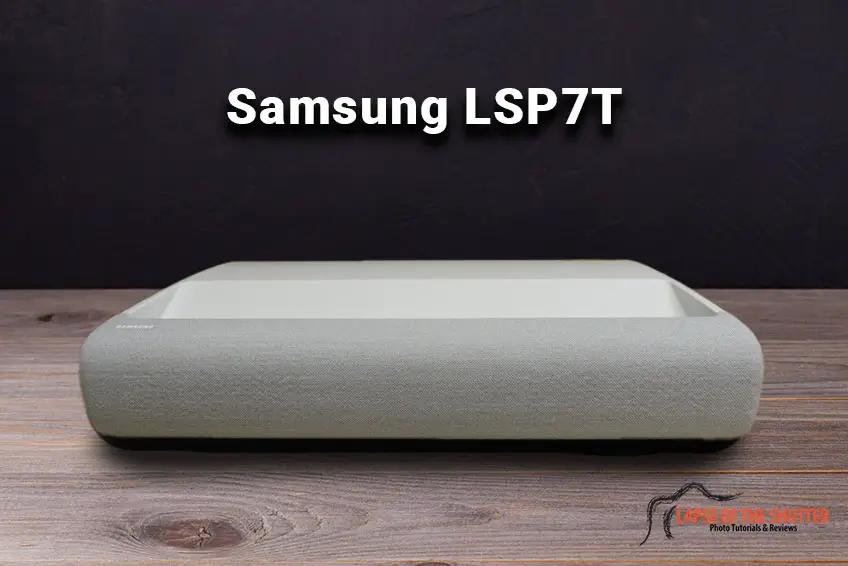
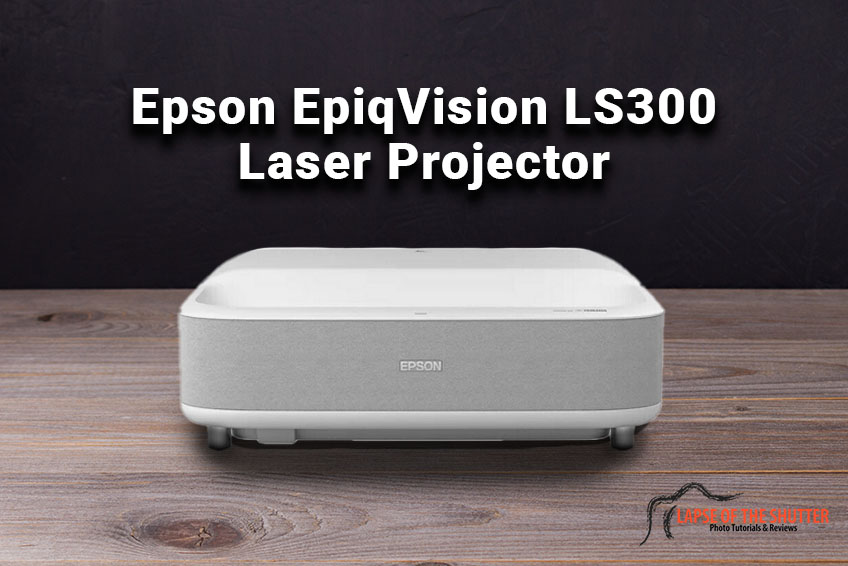
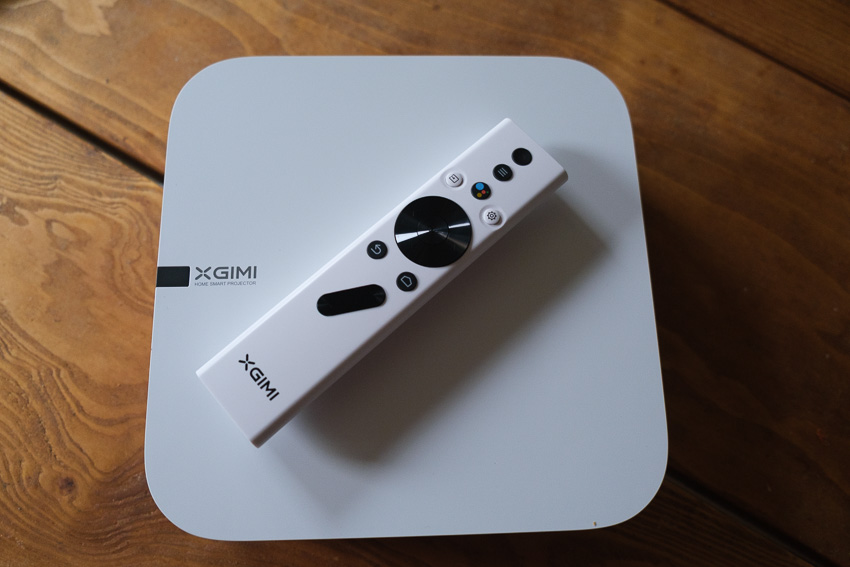

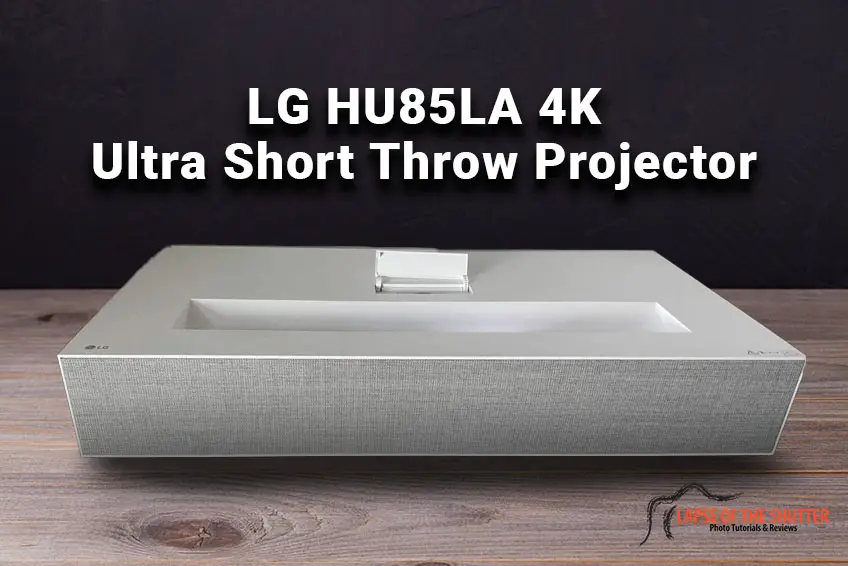
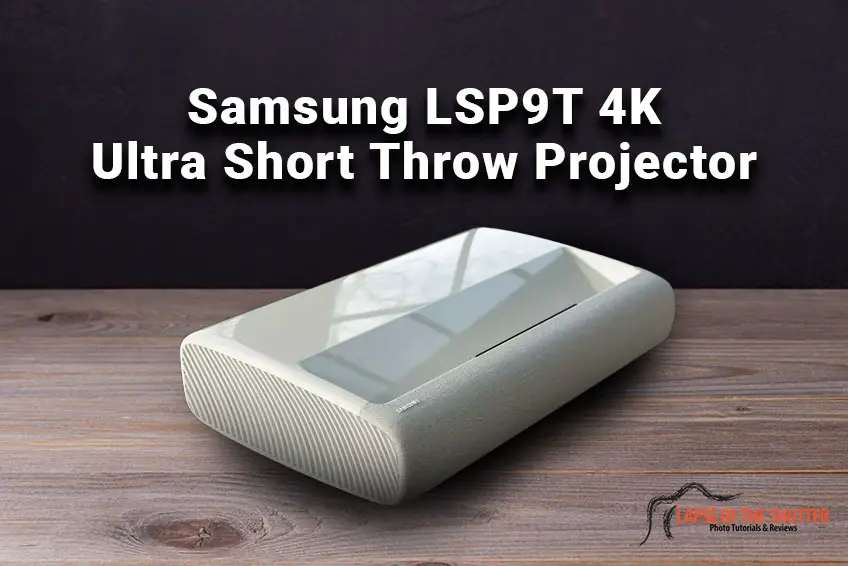
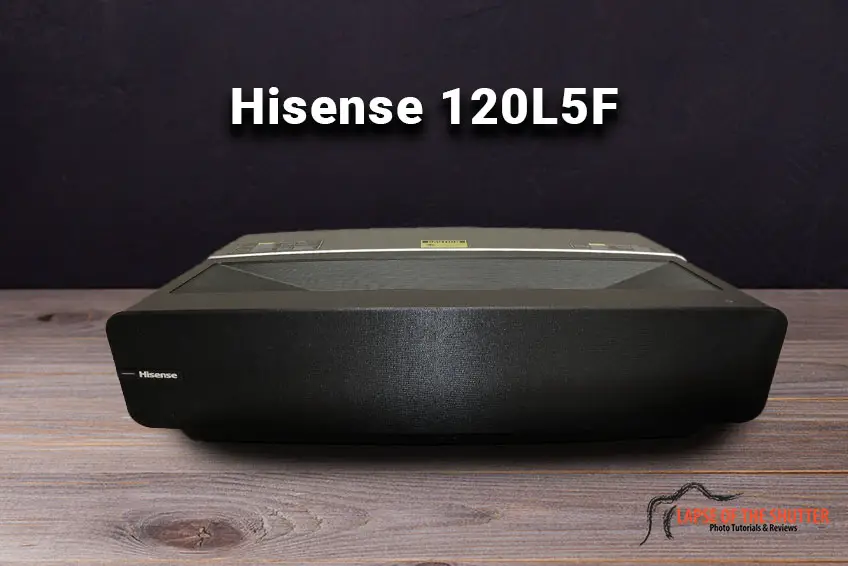
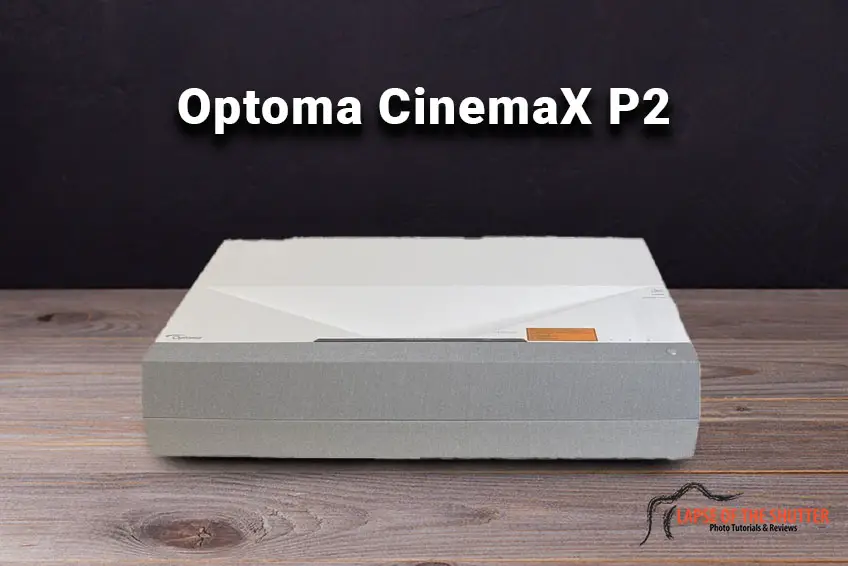
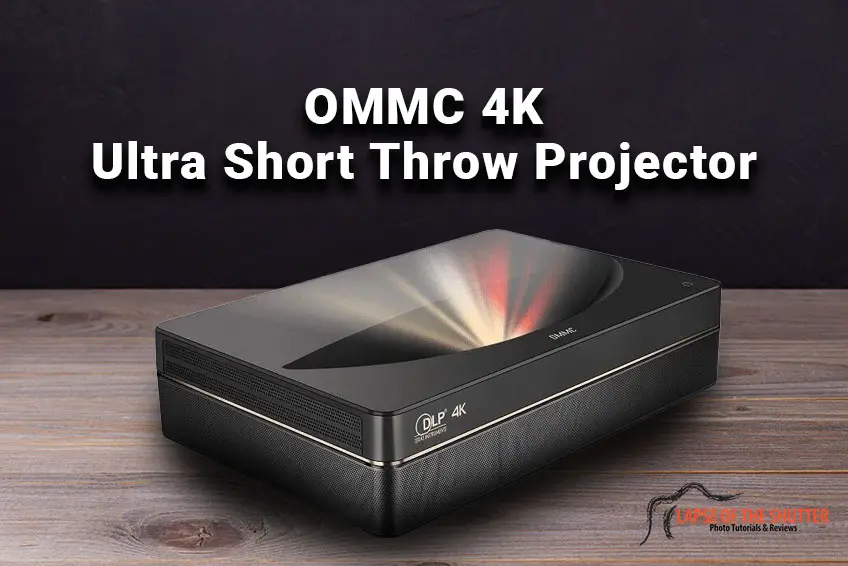
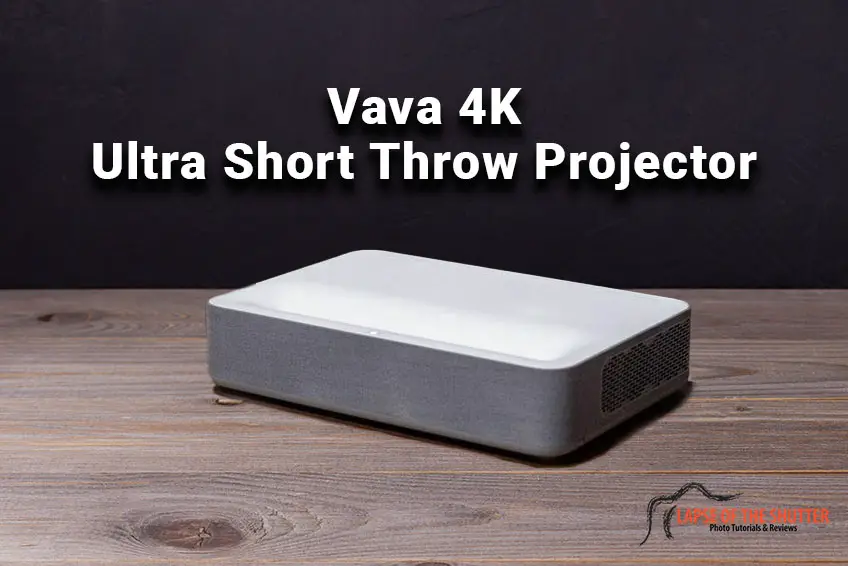

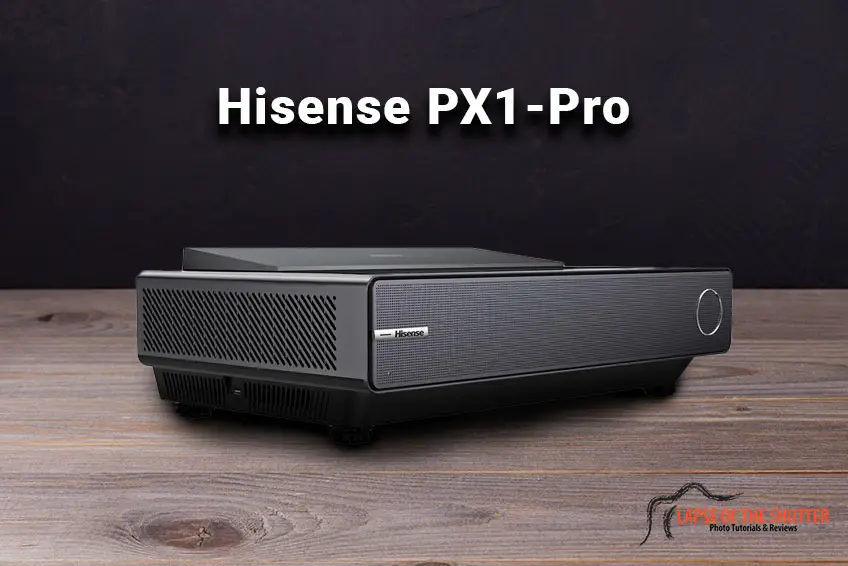
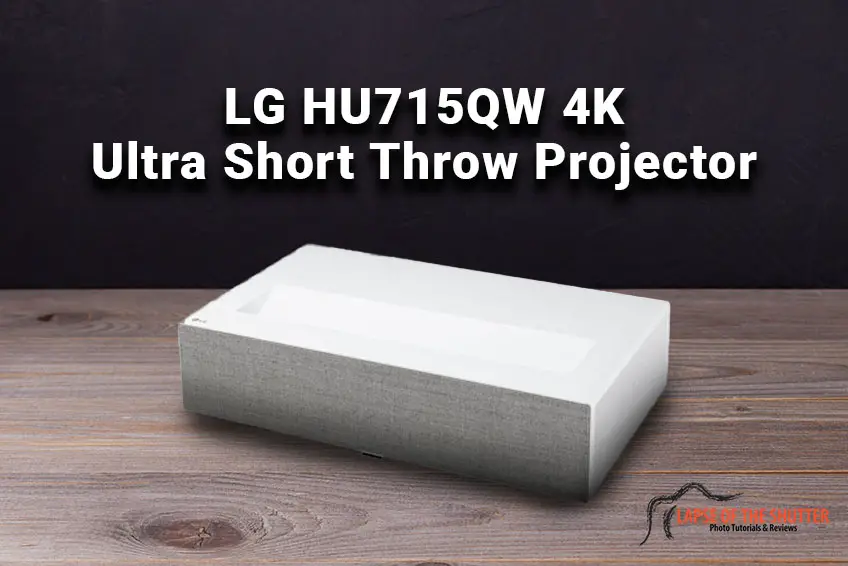
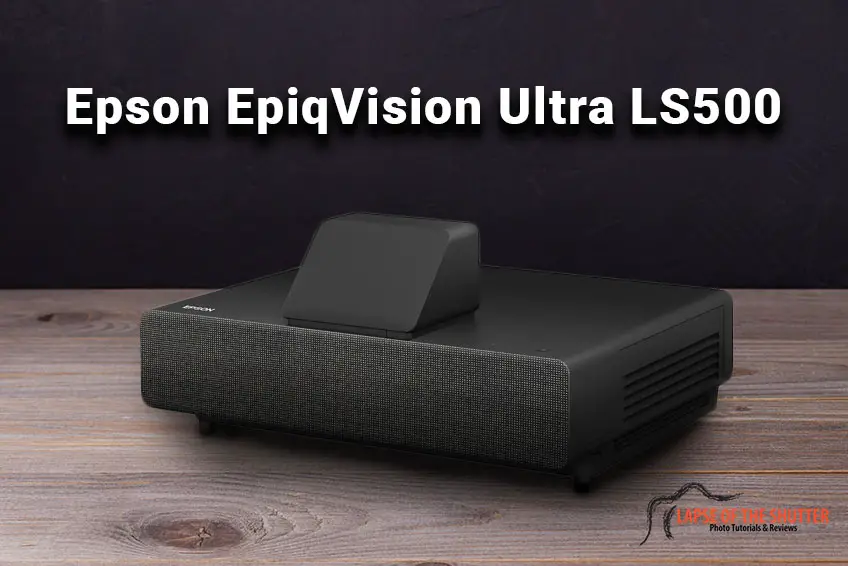


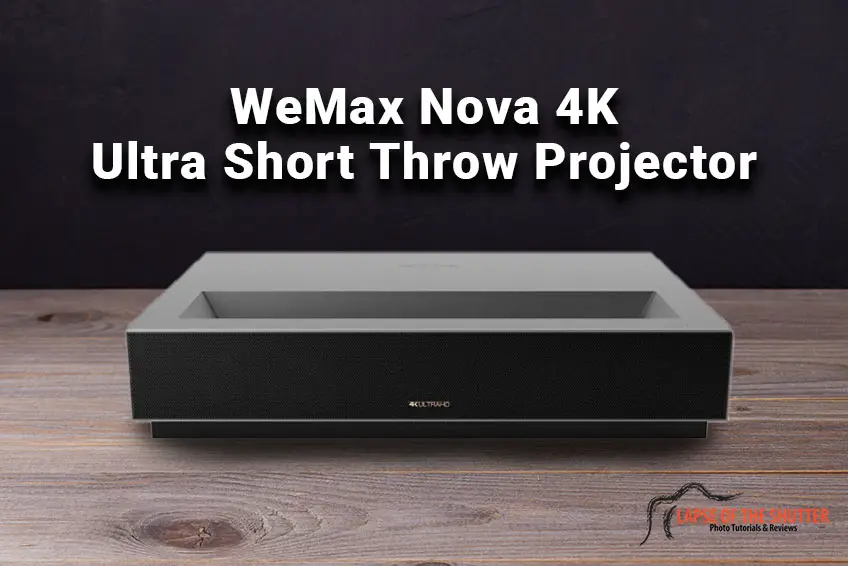
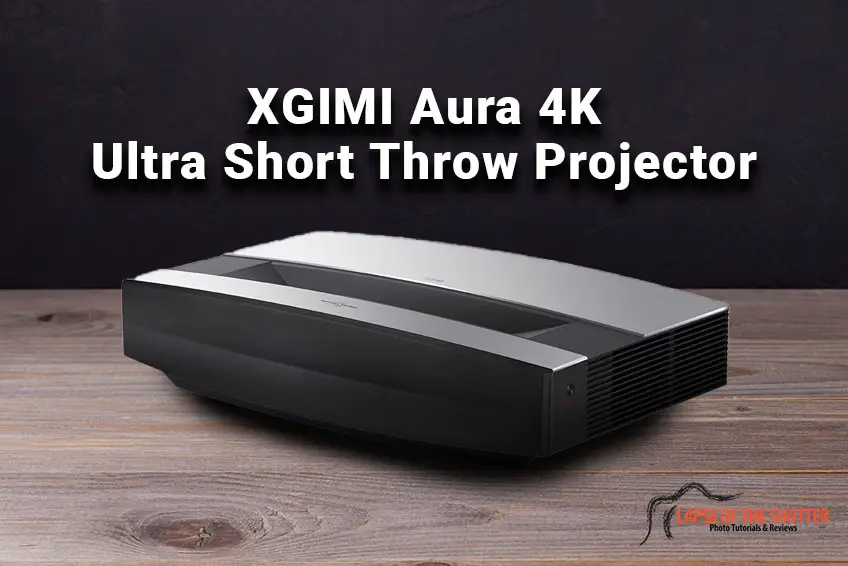







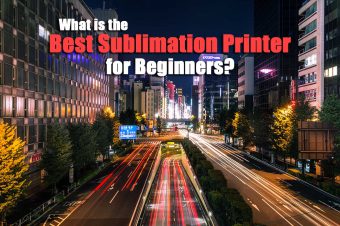
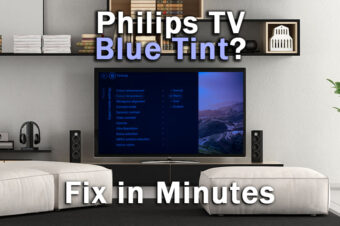
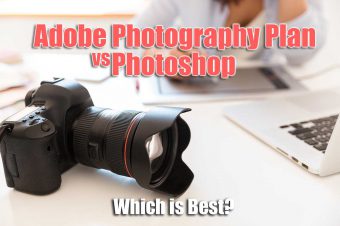
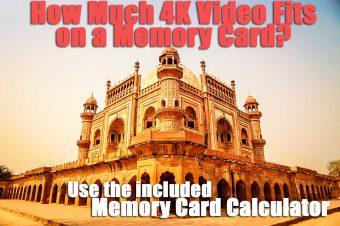
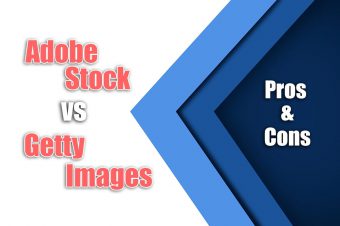
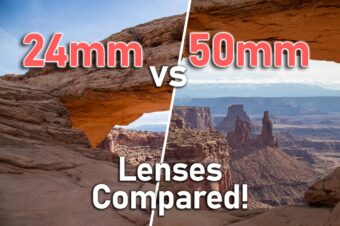
4 Responses
Anton C
Ls500 is pixel shift projector
Tim Daniels
Thanks for the note
Ian
Hey Tim,
Sorry to say but your guide is incorrect. Many sources that points to Samsung, LG aren’t native 4k. They have pixel shifting sadly…
Tim Daniels
Good catch!
I’ve updated the article to make this clear.